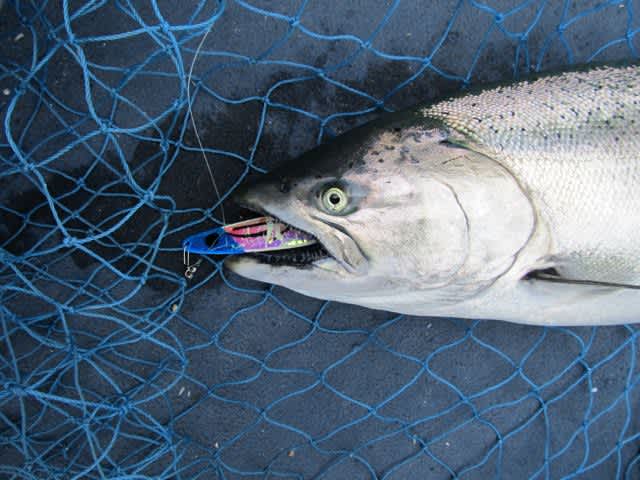Fishing for Fall Salmon and Steelhead on Lake Michigan
Dave Mull 10.19.12

Michiganders who love the outdoors have lots of choices in late October, from archery hunting the prime time for big bucks to field hunting migrating mallards and resident geese. Steelhead and salmon crowd the rivers, while inland lakes have bass, pike and panfish putting on the feedbag. Leaves fall off the trees, making shooting at grouse something more than aiming at the explosive sound of their wings, and pheasant season opens this weekend in much of the state.
Right now, big water Great Lakes trollers can experience some of the most exciting salmon and steelhead action of year. Pursuit of these saltwater transplants sometimes means chasing flocks of birds feeding on the bait that these fish push to the surface in a fall feeding frenzy. Action can be right at the pierheads or well offshore, too.
“The best luck right now for us usually happens out in deep water, catching fish in the top 90 feet, running pretty much the same program you run in spring,” says Captain Chad Bard of Red Baron Charters (269-214-6934, www.itildocharters.com), who keeps his big aluminum Cherokee in its slip at South Haven for as long as possible each year. He explains that late in the year, colder air temperatures cause the thermocline–the abrupt change from warm surface water to colder depths–to disappear. That brings the cold water-loving salmon and steelhead up closer to the surface where they actively feed.

And in the fall, they feed heavily, maybe more heavily than at other times of the year, meaning catching them can be easy.
“We don’t pull the boat until we get three straight nights that the temperature falls below 27 degrees,” Bard says.
His late fall trolling array depends less on flasher/fly combos and more on spoons and body baits.
“Top spoons are often smaller, like Dreamweaver Super Slims,” Bard says. “My top body bait has been the Bomber Long A in a pearl pattern, and my secret weapon is the orange jointed Floating Rapala whenever fish want a hardbody instead of a spoon.
“Lots of times in the late fall we target even higher parts of the water column, targeting the top 40 feet and catching steelhead,” he adds.
“As for speed, I like to go 2.2 and 2.3 miles per hour and sometimes I slow down even more than that,” he says. He usually trolls from shallow water west, into progressively deeper water.
“That way you find the effective depths,” he says. “If you catch your first fish in say 110 feet of water and get bites out to 160 feet but then don’t catch a fish for a good while, it pays to stay in that 110- to 160-foot area, going from east to west then turning around and going west to east. Watch your speed and your direction–both can be critical.”

Fall is when anglers can witness true feeding frenzies, with seagulls marking schools of fish that are pushing bait to the surface. One fall afternoon, this writer experienced this phenomenon, with baits pulled through the diving gulls resulting in kings from 9 to 12 pounds every time. Lure size was everything as the king salmon fed on tiny baitfish and wouldn’t touch big spoons. Small offerings such as Stinger Scorpions were deadly.
When the weather delivers smoother water, anglers with small boats and kayaks can cash in on near-shore opportunities for steelhead and brown trout, too. As the lake water cools, warmer water from tributaries attracts bait, which can bring waves of predators. Savvy small boaters simply troll stickbaits such as Jointed Rapalas, Reef Runner Little Rippers and Bomber Long As. Boaters must watch for lines from pier and shore anglers, now, as anglers on solid ground find consistent action now, too.
Small boaters in shallow water do well to bring along an anchor as pods of predators can concentrate in small areas. When located by trolling, simply pull the other trolling rods, drop the anchor and cast spinners, heavier spoons (the Lindy Viking Spoon and Acme Little Cleo are two faves) or crankbaits such as Shad Raps and Rat-L-Traps. This shallow water bite only gets better as the water gets colder.
For more information on Michigan fishing go to michigan.org.

